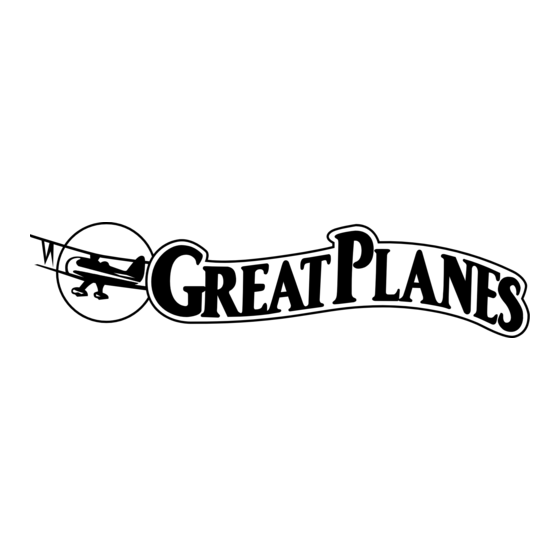GREAT PLANES Gitabria Manual de instruções - Página 14
Procurar online ou descarregar pdf Manual de instruções para Brinquedo GREAT PLANES Gitabria. GREAT PLANES Gitabria 20 páginas. Electrifly series

❏
5. Connect the servos to the receiver so that the wires do
not interfere with any of the pushrods. Note that holes have
been provided to route the elevator and aileron servo wires
to the bottom right side of the fuselage.
❏
6. Position the receiver under the horizontal fuselage as far
aft as possible. Make sure the servo wires do not interfere with
the pushrods. Apply a piece of hook material on the bottom
of the horizontal fuselage, at the receiver location. Attach the
receiver to the fuselage. To prevent the wires from interfering
with the pushrods, use a small piece of tape to attach them
to the fuselage.
❏
7. Install the propeller on the motor following the motor
instructions.
Hint: The rubber o-ring can be diffi cult to stretch over the
screw, then the propeller and over the other screw. A small
jewelers phillips head screwdriver can be used to pry the
rubber o-ring over the screws and propeller. Be careful not
to allow the screwdriver to slip and damage the windings
inside the motor.
BALANCE THE MODEL (C.G.)
More than any other factor, the C.G. (center of gravity/
balance point) can have the greatest effect on how a model
fl ies and could determine whether or not your fi rst fl ight will
be successful. If you value your model and wish to enjoy it
for many fl ights, DO NOT OVERLOOK THIS IMPORTANT
PROCEDURE. A model that is not properly balanced may
be unstable and possibly unfl yable.
Because the Citabria 3D Indoor EP ARF is an indoor lightweight
plane, adding weight to balance the plane is not an option. At
this stage the model should be in ready-to-fl y condition with all
of the components in place except the motor battery. The motor
battery will be moved forward and aft to balance the plane.
❏
1. Use a fi ne-point felt tip pen to mark lines on the bottom of
the wing, 1-15/16" [49mm] from the leading edge of the wing,
on both sides of the fuselage. Apply narrow (1/16" [1.5mm]
strips of tape over the lines so you will be able to feel them
when lifting the model with your fi ngers.
This is where your model should balance for the fi rst fl ights.
Later, you may experiment by shifting the C.G. 5/16" [8mm]
forward or aft to change the fl ying characteristics. Moving
the C.G. forward will improve the smoothness and stability,
but the model will then be less aerobatic (which may be fi ne
for less-experienced pilots). Moving the C.G. aft makes the
model more maneuverable and aerobatic for experienced
pilots. In any case, start at the recommended balance
point and do not at any time balance the model outside
the specifi ed range.
❏
2. Place the motor battery on the top of the fuselage aft of
the recommended C.G. Lift the model from the bottom at the
recommended C.G.
❏
3. If the tail drops, the model is "tail heavy". Move the motor
battery forward to get the model to balance. If the nose drops,
the model is "nose heavy". Move the motor battery aft. Once
you have determined the battery location required to balance
the plane, note the location where the battery would need to
be attached on the bottom of the horizontal fuselage.
14
